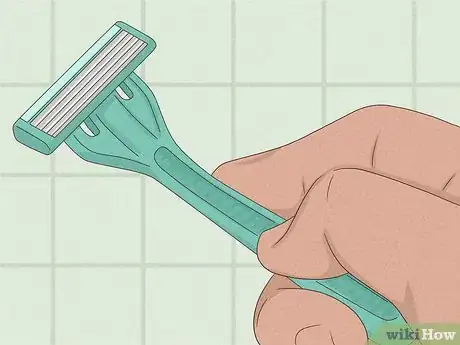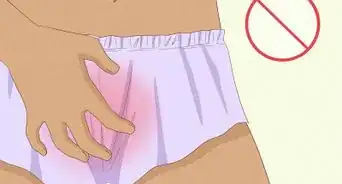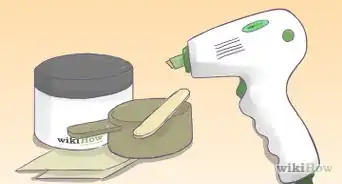This article was co-authored by Juan Sabino. Juan Sabino is a Professional Barber and the Owner of Juan's Barber Shop, a barbershop based in the San Francisco Bay Area. Juan has over 20 years of male grooming experience and over eight years of professional barber experience. He specializes in combovers, barber fades, and tapers and is focused on improving men's overall wellness.
There are 8 references cited in this article, which can be found at the bottom of the page.
This article has been viewed 36,410 times.
A close shave allows you to feel your best and prevents any annoying razor burns and ingrown hairs. With proper tools, a great technique and simple aftercare, shaving will become the favorite part of your day.
Steps
Preparing Your Face
-
1Soften your face with warm water.[1] Soften the skin by taking a shower or by placing a warm, moist cloth and placing it over the skin. Massage your face in circles slowly to assist in pushing the hair out of the skin.[2]
- Try steaming your face by hovering your face atop hot water, while your head is covered by a towel. The steam will encourage your pores to open and soften any tough hair. Be careful to avoid getting too close or steaming for several minutes at a time, as it may dry your face out.
- Cleansing your face before exfoliation will help remove any dirt or bacteria that has been released from pores. If your face is not cleaned beforehand, the bacteria can be pushed down into nicks and cause ingrown hair or acne.
-
2Give your face a gentle exfoliation. Using the circular technique, use an exfoliation cream to lightly scrub your skin. This will prevent dead skin cells from clogging up hair follicles, which causes dreadful ingrown hairs. If you don't own an exfoliating wash, a clean, warm cloth can be used to gently scrub the skin.[3] A gentle rubbing is key, as you do not want to rub your skin raw before shaving.Advertisement
-
3Lather the chosen shaving cream onto your face. Use a small, circular motion to evenly apply a layer of cream.[4] You can use your fingers or a hair brush to apply the cream. Ensure to wash your hands before touching your face. Touching the face with dirty hands can cause acne, especially while your skin is in a fragile post-shave state.
Shaving Your Face
-
1Shave in short, steady strokes with the grain of the hair and rinse the razor after each stroke.[5] Facial hair will grow in different directions on different parts of the face. Try to note the directions before applying your shaving cream. Do not pull your skin taut when shaving as this can cause ingrown hairs.[6]
- After each stroke, rinse the razor well. This removes any excess shaving cream, dead skin or hair build up from the blades.
- Don't press the razor too hard. Remember that the blade does the work, not your muscles.
- When shaving under the nose, it is common for hair to grow down towards the tip and outwards. To prevent cuts, tuck your top lip under your teeth. This will pull your skin taut and will allow better exposure in such a small area. Use the razor and do short, small strokes, while working from the outside towards the middle of the lip. Don't be afraid to only use the corner of the blade. Small strokes will allow for more accuracy and closeness.
- Use a similar trick for shaving the chin, by pulling your lower lip up around your teeth. This will flatten some curves of the chin. When shaving the chin, use short strokes and try your best for for a slight over-lap. The overlap will catch any missed hairs. Don't be afraid to open your mouth and move your jaw in order to have optimum exposure on your chin.
- Hair on the neck will often grow upwards. Use the razor in upward, smooth strokes. Keep in mind the neck can be a very sensitive area, so it is important to shave efficiently.
-
2Shave against the grain (Optional). If your skin is not overly sensitive, do one last shave gently against the grain of the hair.[7] This will cut the stubble directly at the skin but is to be used with caution, as not all faces can withstand this contact.[8]
- When shaving against the grain, the hair is cut as close to the skin as possible. This will give the closest shave possible, but will also remove extra skin. While removing some skin is a normal part of the shaving process, this extra step can cause irritation such as bumps, ingrown hairs, or rashes. Hence, this step may be unacceptable on more sensitive parts of your face.
-
3Rinse and dry your face. Use cool water or a gentle facial cleanser to remove any remaining cream or loose hairs off your face. When drying your face, make sure to use a clean towel. Patting your skin dry, rather than rubbing it, prevents the skin from facing further irritation.
- Use a warm towel to help soften your skin.[9]
-
4Apply aftershave or balm. While your face is moist but not wet, squeeze or spray a small amount of your aftershave into your hands. Rub your hands together and gently apply the aftershave to your shaved face and neck.
Choosing the Right Tools
-
1Choose a clean and sharp, quality safety razor.[10] A quality razor blade means a quality shave. When proper preparation of the skin takes place, you will only need a single blade razor. However, picking a double or triple blade won't hurt your skin and can provide a closer shave.
- Many razors have a pivoting head. This allows for the blade to move smoothly over the curves of the skin, helping ensure a close shave.
- A disposable razor can still be an acceptable razor. Though often low quality, a disposable razor will serve you well when used only once or twice.
- If you desire a high-quality razor, check that the blade head is of similar weight to the handle by balancing the shaft on your finger. An off balance razor can lead to an unequal shave.
- Pay attention to how the handle feels in your hand. If the handle doesn't feel natural to you, there is usually a better option. If the handle is plastic, it may feel too light, and you may overcompensate with additional pressure that can cut your face. A better alternative to plastic is a metal handle, which will feel more hearty and is environmentally-friendly.
- Don't be afraid to replace those blades. When you select your razor, purchase extra disposable heads. Replace them often to prevent nicks, and scratches to your face.
- To extend the lifespan of any razor, disinfect it and dry it after use.[11] Not only will a damp blade harbor bacteria, but the moisture will damage the blade.
-
2Choose a shaving cream. Creams are used to protect the skin from the razor blade. Shaving cream comes in varieties such as soaps, lather-ups, gel and foam. You may want to try them all to see what works for you.
- Although it is not scientifically studied, many users find gels allow closer and more moisturizing shaves.
- Lather-ups and soaps are a more traditional cream and should be used by expert level shavers.
- Foams and gels come in a variety of forms that can be chosen based on your skin type and fragrance preference.
-
3Choose an aftershave. Aftershave is used to reduce skin irritation and close pores. Many types of aftershave or balms are available depending on your skin type. Picking the right aftershave for you can take some experimentation.
- If you have naturally dry skin, choose an aftershave in the form of a balm, gel or lotion. These aftershaves are moisturizing and gentle.
- If you have naturally oily skin, choose an alcohol or toner based aftershave. These aftershaves remove excess oil but sting on open cuts.[12]
Expert Q&A
-
QuestionShould I exfoliate before or after shaving?
 Juan SabinoJuan Sabino is a Professional Barber and the Owner of Juan's Barber Shop, a barbershop based in the San Francisco Bay Area. Juan has over 20 years of male grooming experience and over eight years of professional barber experience. He specializes in combovers, barber fades, and tapers and is focused on improving men's overall wellness.
Juan SabinoJuan Sabino is a Professional Barber and the Owner of Juan's Barber Shop, a barbershop based in the San Francisco Bay Area. Juan has over 20 years of male grooming experience and over eight years of professional barber experience. He specializes in combovers, barber fades, and tapers and is focused on improving men's overall wellness.
Professional Barber Exfoliate your skin before you start shaving! Wash your face with an exfoliating agent to soften up your hair!
Exfoliate your skin before you start shaving! Wash your face with an exfoliating agent to soften up your hair!
Things You'll Need
- Razor blade
- Shaving cream
- Water
- Towel
- Aftershave
- Shaving brush (Optional)
References
- ↑ Juan Sabino. Professional Barber. Expert Interview. 28 January 2020.
- ↑ http://www.webmd.com/men/features/getting-close-shave
- ↑ http://www.webmd.com/skin-problems-and-treatments/guide/ingrown-hair-causes-symptoms-treatment
- ↑ Juan Sabino. Professional Barber. Expert Interview. 28 January 2020.
- ↑ Juan Sabino. Professional Barber. Expert Interview. 28 January 2020.
- ↑ http://www.mayoclinic.org/diseases-conditions/ingrown-hair/in-depth/health-tip/art-20049081
- ↑ Juan Sabino. Professional Barber. Expert Interview. 28 January 2020.
- ↑ http://gillette.com/en-us/shaving-tips/how-to-shave/against-the-grain
- ↑ Marlon Rivas. Facial Hair Specialist. Expert Interview. 17 January 2020.
- ↑ Juan Sabino. Professional Barber. Expert Interview. 28 January 2020.
- ↑ Juan Sabino. Professional Barber. Expert Interview. 28 January 2020.
- ↑ http://www.webmd.com/men/fit-and-healthy-10/slideshow-mens-skincare-tips
- ↑ Juan Sabino. Professional Barber. Expert Interview. 28 January 2020.
- ↑ http://www.webmd.com/beauty/dry-skin-13/cosmetic-procedures-skin-care-dry-skin
About This Article
To get a close shave, start by softening your face with warm water and massaging your skin in circles to help push the hair out of your skin. Next, exfoliate your face by gently scrubbing with a warm washcloth to prevent ingrown hairs and lather on an even layer of shaving cream. Then, using a high-quality razor, shave in short, steady strokes with the grain of the hair and rinse the razor after each stroke. When you’re finished, rinse your face with cool water, pat your skin dry with a clean towel, and apply an aftershave to reduce irritation and close the pores. For more tips, like how to choose the right razor, read on!












-Step-14.webp)







-Step-10-Version-2.webp)










-Step-14.webp)





































